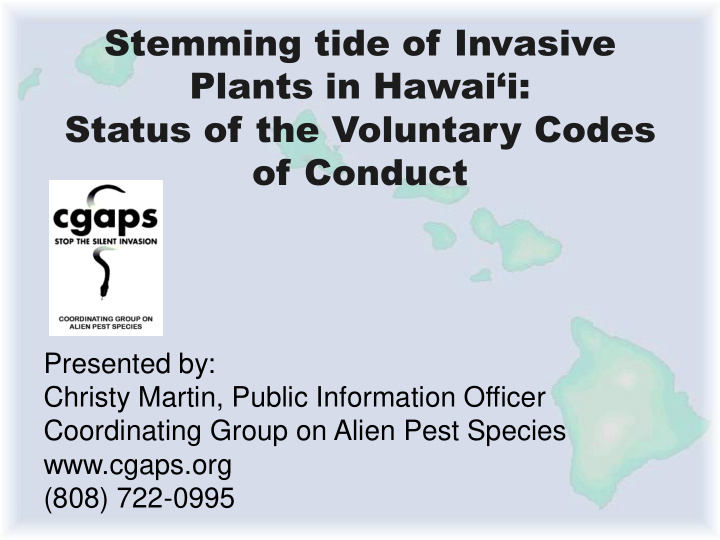



Stemming tide of Invasive Plants in Hawai‘i: Status of the Voluntary Codes of Conduct Presented by: Christy Martin, Public Information Officer Coordinating Group on Alien Pest Species www.cgaps.org (808) 722-0995
Hawaii's First Arrivals: On Wind, Wings and Water
Isolation + wide variety of habitats + 70 million years >> changes over time = native Hawaiian species
Non-native (Alien) species = 34 ...a few, like rats, proved to be Invasive 1500 Years Ago
Non-native (Alien) species = 500? ...a few of these, including goats and mosquitoes, proved to be invasive 226 Years Ago
Non-native (Alien) species = 5000+? • 343 new marine/brackish water species • Hawaii went from 0 to 40 land reptiles • 0 to 6 amphibians (including coqui) • More than 20 insects become established each year. 2 Years Ago
It is LEGAL to import into Hawaii 99% of the plants that exist on Earth, no questions asked about how invasive they might be. Here's how we've done so far: 8,000+ plants introduced; 470 considered "invasive"; 200 of these causing ecosystem damage Today
Challenge: New plant species continue to be imported without being assessed for their invasive potential. Federal Noxious Weed List -mostly addresses agricultural weeds -must threaten a substantial portion of USA HI State Noxious Weed List -not designed to keep listed plants from being imported; majority are agricultural weeds with a few forest weeds HI Seed Rules; HI Restricted Plants List -Rules for the Restricted Plants allow listing of plants that may carry pests, recently (2008) changed to allow for the addition of invasive plants, added the plants on the Nox Weed list, but to date (2014), no additional invasive plants have been listed. …So, protecting Hawai‘i is reliant on awareness, concern, and buy-in.
We have a great tool: the Hawai‘i Pacific Weed Risk Assessment (HPWRA) • Modified by Univ. of Hawaiʻi researcher Dr. Curt Daehler from the NZ/Australia WRA in 1998, work and testing through 2005; it correctly flags 95% of invasive plants as high risk. • Hawaiʻi Invasive Species Council now hosts and supports the HPWRA technician to conduct assessments. It is a free, non- binding, non-regulatory information service.
Outreach on HPWRA 2002: Started statewide outreach on HPWRA. Rough start. 2005: started working on the Codes of Conduct as a way to become familiar with the uses of the HPWRA. By signing the Codes of Conduct, you pledge to: • Have new plant introductions screened for their potential to be invasive in Hawaii (using the HPWRA). • Work with natural resource/conservation groups to identify some incipient (not widespread) invasive plants and agree to discontinue use/sale of these plants wherever possible*. • Identify non-invasive alternatives and help promote the use of non-invasives. *one issue that arose was that the number of plants were usually limited to 10 or so species. However, the agreement to use the HPWRA on all future imports outweighed this small number.
Codes of Conduct to-date • Oahu Nursery Growers Association (ONGA) • Kaua‘i Landscape Industry Council (KLIC) • Hawai‘i Island Landscape Association (HILA) • Maui Association of Landscape Professionals (MALP) • Wal- Mart Garden Marts of Hawai‘i • National Tropical Botanical Garden • Lyon Arboretum • Waimea Valley Audubon Center/OHA • Landscape Industry Council of Hawaiʻi, Hawaiʻi ASLA (HASLA) support the concept without signing; support led to a larger effort…
2008 Plant Industry Survey Results • Written survey distributed by CGAPS at the 2008 LICH Conference & via industry association email lists for online survey. 104 responses collected • Survey participants work on various islands
2008 Plant Industry Survey Results • Survey participants activities varied within the industry
2008 Plant Industry Survey Results • 59% had heard of the Hawai‘i Pacific Weed Risk Assessment (HPWRA), right • Of those, nearly 68% had used it to get information about a plant
2008 Plant Industry Survey Results • Over 56% said that the HPWRA provided information that resulted in a change in plant use • Over 90% feel that the HPWRA can provide useful information about the potential of a plant to become invasive in Hawaiʻi
2008 Plant Industry Survey Results • 81% are in support of the HASLA invasive plant initiative • The HASLA initiative uses information from the Hawai‘i Pacific Weed Risk Assessment (the green industry has been using the Weed Risk, perhaps without realizing it)
2008 Plant Industry Survey Results • Nearly 67% of respondents believe that mandatory screening of new plant imports using the HPWRA is prudent & could help • Nearly 64% of respondents believe that regularly updating noxious and restricted plant lists is prudent & could help
Mahalo (Thank you)! Christopher Dacus, ASLA Landscape Architect--Highways Division Hawai‘i State Department of Transportation Christopher.A.Dacus@hawaii.gov Christy Martin, Public Information Officer Coordinating Group on Alien Pest Species christym@rocketmail.com (808) 722-0995
Recommend
More recommend